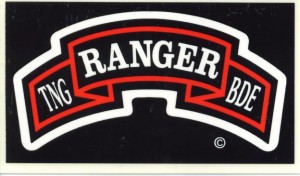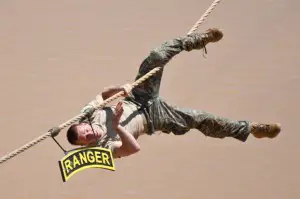 On the Ranger School Preparation .pdf document, posted at the RTB’s official website, the Ranger Physical Fitness Test (RPFT) is described as one of the Ranger Assessment Phase’s, “key Must Pass Events that require a GO in order to continue your Ranger training.” As far as RAP Week itself, the first three days (despite the name) of Ranger School, it’s the key to School attrition:
On the Ranger School Preparation .pdf document, posted at the RTB’s official website, the Ranger Physical Fitness Test (RPFT) is described as one of the Ranger Assessment Phase’s, “key Must Pass Events that require a GO in order to continue your Ranger training.” As far as RAP Week itself, the first three days (despite the name) of Ranger School, it’s the key to School attrition:
45% of all students who start Ranger School fail to graduate. Over half of those are dropped because they failed a RAP Week event…. The RPFT accounts for approximately 25% of all RAP Week failures. Most of the RPFT failures occur during the Push-Up event.
(Yes, elsewhere the RTB says that 49.87% of students quit or fail. We doubt there’s anything sinister in this, just documents that were prepared some years apart, and normal variability in this statistic from year to year. We note that the 49.87% number is presented as a multi-year average). For our purposes the exact number doesn’t matter: stipulated, a whole bunch of would be Rangers’ hopes are dashed on the first few days. Let’s go back to the Ranger School Preparation document to see what the RTB’s take-away from this is:
The bottom line: RAP Week Attrition is a direct result of students that are physically unprepared to achieve the minimum standards. 33% of all Ranger School graduates are recycled, at least once, for failure to meet the standard….
Hard to argue with that. Everything that the trainee must do in RAP Week is published on the website, enumerated in tons of documents, slide shows and videos, and verbally available from any Ranger-tabbed officer or soldier (most of whom are enthusiastic about seeing their friends, acquaintances, peers and subordinates tackle this course and succeed). These standards have not changed significantly in a long time. RAP week was once a week, and there were once several graded Ranger Runs in that first week. Some time over the last thirty years, formation running in boots and uniform has been replaced as a culling methodology. (The reason is obvious: running in boots produces unnecessary injuries).
The Ranger Physical Fitness Test (RPFT) conducted in RAP Week is different from the Army PFT (APFT). The principal differences are:
- the Ranger test has a single standard for all soldiers, the Army standards vary with age and sex.
- the Ranger test scores are higher than average, although not higher than the male max in the typical young age groups that succeed at Ranger school (the Army now expects most measures of fitness to peak at about age 30; until five or so years ago, they actually expected fitness to steadily decline after one left the 17-21 age group).
- the Ranger test is administered with absolute and strict attention to the regulation form and performance of each event. Head-bob pushups or half-way situps won’t be counted. As a result, many men who come with PT cards indicating a max score leave after failing the test.
- the Ranger test includes pull-ups. These were once a staple of Army physical fitness training and Army PT tests, but when the Army went to the current three-event test (pushups, situps, 2-mile run), they were dropped. Airborne and Ranger schools, and most special operations selection programs, still require them.
The actual events on the Ranger PFT are these, compared with Army standards for the 17-21 year old group (not always the highest scoring group, but chosen for simplicity and consistency. Most Ranger students range — no pun intended — from 18 to 26 years old):
| Ranger PFT | Army PFT Men (17-21) |
Army PFT Women (17-21) | |||
| Event | Min | Max | Min | Max | |
| Push-up | 49 | 42 | 71 | 19 | 42 |
| Sit-up | 59 | 53 | 78 | 53 | 78 |
| 2 Mile Run | X | 15:54 | 13:00 | 18:54 | 15:36 |
| 5 Mile Run | 40:00 | X | X | X | X |
| Per Mile Speed | 8:00 | 7:57 | 6:30 | 9:07 | 7:38 |
| Pull-up | 6 | X | X | X | X |

This rope traverse in Ranger School is a one-time deal, not part of the PT test. One example of the physical demands on the Ranger candidate.
Sorry for the homely table. “X” means that test does not include that event. The Ranger test includes two events the ordinary test never includes: pull-ups and five mile run. Note that while the sit-up scores are the same for both sexes, the other scores are so heavily sex-normed that the female max score would be a skin-of-the-teeth pass for men. Note that the 5-mile run pace for the Ranger PFT is close to the minimum for men, and a bare 22 sec/mile off the max for women. (Although a 40 minute 5-mile run should not be an insuperable requirement for a fit young woman). The pull-ups are also something women can master, but very few do. Finally, note that in most of the Army, scoring on this test is very lax. Repetitions of the exercises that fly in one’s home unit will be laughed off at Ranger School — at least, until the inevitable standards plunge that’s coming in 2013.
There is the whole other question of: does this test adequately measure soldiers’ preparedness for service in Ranger units, particularly the Ranger Battalions? Is it a good test of combat fitness? Not particularly, except that it is a much higher than the ordinary APFT standard, as evidenced by the literally thousands of young soldiers who come to Ranger School thinking they’re fit enough only to be taking the Ride of Shame the first day of the course. But please understand this: Ranger School and the Ranger Regiment of fighting Ranger Units are two separate universes. Ranger School is a leadership school using environmental stress and small unit patrolling (squad to two-platoon-size operations) as a training vehicle. It’s used by the Regiment as a gut-check for promising soldiers and potential officer or NCO leaders (although most infantry officers complete it as part of their initial accession training).
From time to time, other units including particular Special Forces Groups and light infantry units have tried to make Ranger School mandatory for small-unit leaders, which works a little better for officers (who have more opportunity to attend the course as juniors) than for NCOs, and generally collapses when the general or colonel behind the Good Idea transfers out. The Ranger Tab is becoming fairly rare on conventional Infantry NCOs, possibly driving the perception of the brass that it’s a shiny badge for officers, meant as a uniform doodad alone and unmoored from combat utility (which has been the reality of the Pathfinder Badge for 30 years). That perception in turn is one part of the impetus for women in Ranger School. The other parts are desire to one-up the Marines, as explicitly admitted by the very non-Ranger Chief of Staff, and the push for women in Infantry, coming from the suit-wearing social engineers in the E Ring.
But one of the reasons the Chief of Staff gave for dropping standards, if that’s what’s needed to produce Rangerettes on a schedule driven by partisan politics, is that Benning can’t tie the standards to a combat requirement. Hmmm… want a combat Ranger Fitness test? Well, buckaroos, this paper from 1999 [.pdf file] is a partial answer. Major Michael Pemrick, a former Ranger Battalion Company Commander, examined both the current fitness program of the 75th (Ranger) Infantry Regiment, and the Regiment’s Mission Essential Task List, and came up with what he thought was a more combat-oriented test, to be given in addition to the regular APFT.
| Combat PFT | ||
| Event | Standard | Conditions |
| 5 Mile Road March | 15 min/mile min10 min/mile to max | 45 lb. equipment |
| Rope Climb | 1 climb to pass3 climbs to max | Begin at end of Road March without rest.30 foot rope2 minutes |
| Casualty Carry | 150 m | Begin at end of Rope Climb without rest.Carrying a Ranger of equal body weight |
There are many other thoughtful gems in this paper. One of Maj. Pemrick’s more interesting conclusions was that strength, relative to body weight, is an important factor.
The ideal is that a Ranger has enough size to better support the weight of a heavy rucksack or a fellow Ranger while being strong enough relative to his body weight to climb effectively. To put it simply a 140 pound Ranger who can climb and do pull-ups all day long will be less able to carry eighty or a hundred pounds of combat equipment, while the 220 pound Ranger who can handle that weight with less stress may have trouble pulling his own body weight while climbing.
Pemrick’s paper is now quite old. It doesn’t quite apply because the Regiment’s METL has changed a good bit in the years since 1999, as has the equipment of the combat Ranger. But it shows the path to something that GEN Odierno has said does not presently exist: combat-oriented, operationally required standards.
Except…in the Ranger Battalions (as in SF, that has its own internal PT standards), they have been doing combat-oriented PT for a long time; Major Pemrick, wherever he is, would probably be pleased. The estimable Jack Murphy at SOFREP had the story a while ago.
RTWT, of course, but the test used in Jack’s battalion had six events, and was even more combat-oriented than the CPFT suggested above, although it also required more gear:
- Conduct a 2-mile run wearing ACUs (Army Combat Uniform), boots, RBA (Ranger Body Armor) and MICH helmet. The run will begin and end at a 20-foot fast rope.
- After the completion of the run, immediately climb the 20-foot fast rope and do a controlled descent.
- When the rope climb is complete, drag a 160-pound SKEDCO litter 50 yards, turn round and drag it back 50 yards to the start point.
- Immediately following the SKEDCO pull, climb a 20-foot caving ladder and climb all the way back down.
- At the bottom of the Caving ladder, sprint 100 yards, turn around, sprint back 100 yards and climb over the 8-foot wall.
- Conduct a 1 mile run wearing ACUs, boots, RBA and MICH helmet. The run will begin and end at the 8-ft wall. Time stops when you cross the line at the 8-foot wall.
Note that two of Pemrick’s events, the rope climb and a version of the casualty carry (a drag instead) are here. The standards? By the time you’re taking this test, you’re in the Regiment and through RIP. If you aren’t pro-athlete-fit by now, you’re gone. So the standard for this test is to get better every time. It also reflects on the squad as well as the individual, so individual Rangers are competitively motivated to help their buddies’ fitness improve.
We’d sure love to see the times the Rangers are doing this evolution in, assuming that they’re still doing it.

Kevin was a former Special Forces weapons man (MOS 18B, before the 18 series, 11B with Skill Qualification Indicator of S). His focus was on weapons: their history, effects and employment. He started WeaponsMan.com in 2011 and operated it until he passed away in 2017. His work is being preserved here at the request of his family.
